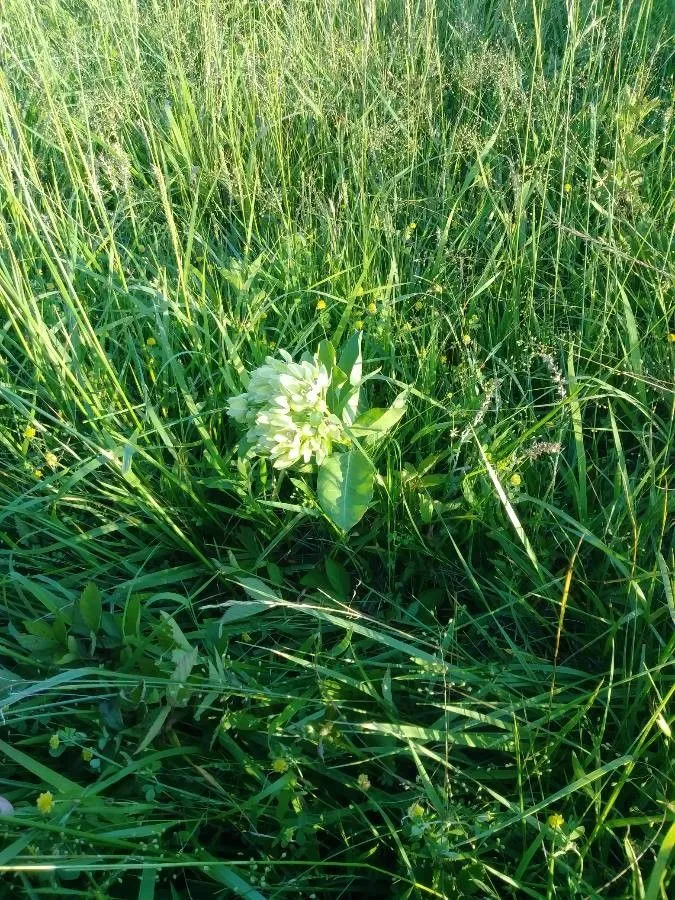
Author: Walter
Bibliography: Fl. Carol.: 107 (1788)
Year: 1788
Status: accepted
Rank: species
Genus: Asclepias
Vegetable: Unknown
Observations: C. & EC. U.S.A.
Antelope-horns, scientifically known as Asclepias viridis, is a distinctive and ecologically important plant native to the central and eastern regions of the United States. This perennial herbaceous plant belongs to the family Apocynaceae, a diverse group that is often celebrated for its ornamental and medicinal properties.
Asclepias viridis is named for its unique seed pods that bear a striking resemblance to the curved horns of an antelope, making it easily recognizable among the verdant landscapes it inhabits. The plant typically thrives in open prairies, pastures, and along roadsides, where it enjoys full sunlight and well-drained soils. Its adaptability to various soil types and resilience against drought make it a hardy species, well-suited to the fluctuating climates of its native range.
The foliage of Antelope-horns is characterized by its broad, lance-shaped leaves that are arranged opposite each other along the stem. These leaves are not only vital for photosynthesis but are also a primary food source for the larvae of the Monarch butterfly (Danaus plexippus), making Asclepias viridis a critical component of the Monarch’s lifecycle. In addition to supporting Monarch populations, the plant provides nectar to a variety of pollinators, including bees, wasps, and other butterfly species, thus playing a significant role in maintaining biodiversity and ecosystem health.
In the late spring and early summer, Antelope-horns showcase clusters of small, greenish-white flowers that exhibit a complex structure typical of the milkweed genus. These blooms are both intricate and visually appealing, attracting numerous pollinators which facilitate cross-pollination. The flowers are followed by the development of the plant’s namesake seed pods. Once mature, these pods split open to release seeds adorned with silky tufts that facilitate wind dispersal, ensuring the propagation of future generations.
The first formal description of Asclepias viridis was authored by Thomas Walter in 1788, as recorded in his work “Flora Caroliniana.” Walter’s observation and documentation of this species contributed significantly to the early botanical understanding of North American flora.
In summary, Antelope-horns (Asclepias viridis) is a resilient and ecologically valuable plant. It serves not only as a vital food source for Monarch butterfly larvae but also as an essential nectar provider for a host of pollinating insects. Its distinctive appearance and adaptive nature make it an important species for conservation efforts and a compelling subject for study among botanists and ecologists alike.
Eng: antelope-horns, green antelope-horn, green antelopehorn, green milkweed, spider milkweed
En: Antelope-horns, Green antelope-horn, Green milkweed, Spider milkweed, Green antelopehorn
Taken May 20, 2020 by Aaron Harp (cc-by-sa)
Taken Aug 13, 2022 by Justin Nickel (cc-by-sa)
Taken Sep 6, 2022 by craig jackson (cc-by-sa)
Taken May 15, 2020 by d S (cc-by-sa)
Taken Feb 6, 2022 by Lucilia Ortega (cc-by-sa)
Taken May 20, 2020 by Aaron Harp (cc-by-sa)
Taken Sep 1, 2019 by Christopher Christopher Marsh (cc-by-sa)
Taken Jun 11, 2021 by Jessica Richter (cc-by-sa)
Taken May 20, 2020 by Aaron Harp (cc-by-sa)
Taken Jul 12, 2021 by Susan Mitchell (cc-by-sa)
Taken Jun 6, 2015 by EOL − Miranda Kersten (cc-by-nc)
Taken May 24, 2020 by Kyle Grubb (cc-by-sa)
Taken May 26, 2020 by Aaron Harp (cc-by-sa)
Taken May 20, 2020 by Aaron Harp (cc-by-sa)
Taken May 20, 2020 by Aaron Harp (cc-by-sa)
Taken Jun 17, 2015 by EOL − andy (cc-by-nc)
Taken Jun 17, 2015 by EOL − Jason Singhurst (cc-by-nc)
Taken Jul 17, 2005 by EOL − Darel Hess (cc-by-nc-sa)
Taken May 6, 2015 by EOL − Jason Singhurst (cc-by-nc)
Taken Jun 10, 2014 by EOL − Judith Lopez Sikora (cc-by-nc)
Taken May 4, 2019 by Joshua Kuykendall (cc-by-sa)
Taken May 24, 2020 by Kyle Grubb (cc-by-sa)
Taken Sep 14, 2015 by EOL − Linda Jo Conn (cc-by-nc)
Taken May 20, 2020 by Aaron Harp (cc-by-sa)
Taken May 20, 2020 by Aaron Harp (cc-by-sa)
© copyright of the Board of Trustees of the Royal Botanic Gardens, Kew.
Family: Myrtaceae Author: (F.Muell.) K.D.Hill & L.A.S.Johnson Bibliography: Telopea 6: 402 (1995) Year: 1995 Status:…
Family: Rubiaceae Author: Pierre ex A.Froehner Bibliography: Notizbl. Bot. Gart. Berlin-Dahlem 1: 237 (1897) Year:…
Family: Sapindaceae Author: Koidz. Bibliography: J. Coll. Sci. Imp. Univ. Tokyo 32(1): 38 (1911) Year:…
Family: Asteraceae Author: A.Gray Bibliography: Pacif. Railr. Rep.: 107 (1857) Year: 1857 Status: accepted Rank:…
Family: Fabaceae Author: Medik. Bibliography: Vorles. Churpfälz. Phys.-Ökon. Ges. 2: 398 (1787) Year: 1787 Status:…
Family: Aspleniaceae Author: (Cav.) Alston Bibliography: Bull. Misc. Inform. Kew 1932: 309 (1932) Year: 1932…